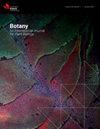Effects of industrial disturbances on the flavonoid concentration of Rhododendron groenlandicum
IF 1.3
4区 生物学
Q3 PLANT SCIENCES
引用次数: 0
Abstract
The boreal forest is subject to various anthropogenic disturbances, including logging, mining, and hydroelectricity production and transport. These disturbances affect Indigenous communities and the culturally salient species they depend on for the practice of traditional and subsistence activities. Rhododendron groenlandicum is one such species whose leaves are used to treat various ailments, due to their concentration in biologically active chemicals such as flavonoids. Our objective was to assess the effect of anthropogenic disturbances on the chemical properties of R. groenlandicum on the territories of three Indigenous communities. Leaf samples were collected near mines, under hydroelectric power lines, and in non-disturbed sites. Our results showed that variations in flavonoid concentration were mainly related to territory (R² = 0.43, P = 0.0005), while disturbance type had a smaller effect (R² = 0.18, P = 0.02). Samples from Nemaska, the northernmost territory with the most open forest stands, had higher concentrations of epicatechin (+23%, P = 0.03). Quercetin-3-glucoside concentrations were lower near mines (-19%, P = 0.01). The effects of disturbances on the chemical signature of R. groenlandicum are complex, and a complete assessment of the consequence of industrial activity on Indigenous landscape value must take into account other culturally salient species.工业干扰对杜鹃类黄酮浓度的影响
北方森林受到各种人为干扰,包括伐木、采矿、水力发电和运输。这些骚乱影响到土著社区和他们从事传统和生计活动所依赖的文化上突出的物种。groenlandicum杜鹃就是这样一个物种,其叶子被用于治疗各种疾病,因为它们富含黄酮类等生物活性化学物质。我们的目标是评估人为干扰对三个土著社区领土上R.groenlandicum化学性质的影响。在矿山附近、水力发电线路下和未受干扰的地点采集了树叶样本。我们的结果表明,类黄酮浓度的变化主要与地区有关(R²=0.43,P=0.0005),而干扰类型的影响较小(R²=0.018,P=0.02),具有较高的表儿茶素浓度(+23%,P=0.03)。槲皮素-3-葡萄糖苷在矿山附近的浓度较低(-19%,P=0.01)。干扰对groenlandicum化学特征的影响是复杂的,对工业活动对土著景观价值的影响的全面评估必须考虑到其他文化显著物种。
本文章由计算机程序翻译,如有差异,请以英文原文为准。
求助全文
约1分钟内获得全文
求助全文
来源期刊

Botany
生物-植物科学
CiteScore
2.20
自引率
9.10%
发文量
48
期刊介绍:
Botany features comprehensive research articles and notes in all segments of plant sciences, including cell and molecular biology, ecology, mycology and plant-microbe interactions, phycology, physiology and biochemistry, structure and development, genetics, systematics, and phytogeography. It also publishes methods, commentary, and review articles on topics of current interest, contributed by internationally recognized scientists.
 求助内容:
求助内容: 应助结果提醒方式:
应助结果提醒方式:


